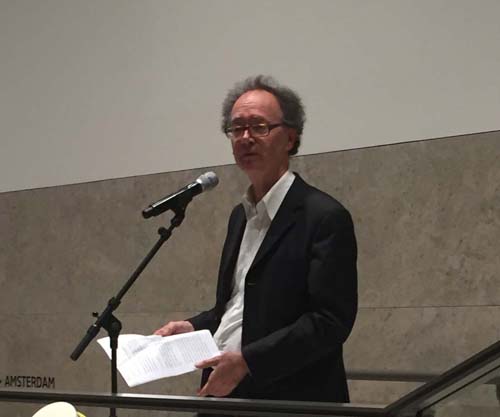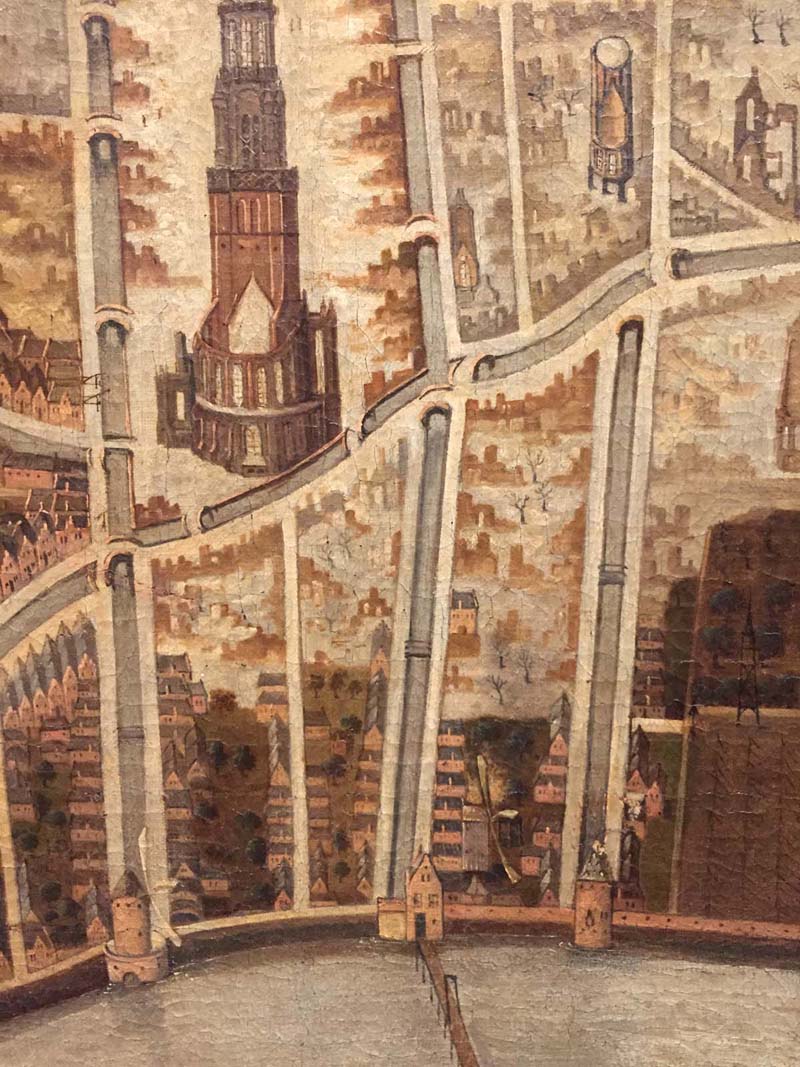Go to Dutch text
Velasquez-Pareja-restoration booklet.
On November 20, 2015 in the Amsterdam Rijksmuseum the small but fine exhibition opened its doors on the Little Street by Vermeer. It presents proofs and results of research by prof. Frans Grijzenhout of the UvA, who finally has found the key to identifying the exact spot in Delft.
That key solved a riddle in which specialists for 100 years have tried to get answers- in vain. Former research (including that by Kaldenbach, seen lecturing on the right hand top) contained a number of preconditions: a position on a canal, a building on the north side, seen from a distance of about 17 meters, a building with a given width. The result by Grijzenhout is now contained in a nice, handy and above all readable publication which appeared authored by Grijzenhout and the Rijksmuseum in which this research and the results are presented. Chapeau!

Grijzenhout (photo to the right by Kaldenbach) discovered the potential value of a rarely used tax-list in the archives in Delft, the tax ledger: Legger van het Diepen der Wateren. Each resident living on a Delft canal had to pay taxes as measured by the exact width of the house by the canal. This tax Money ensured the canal would be properly maintained and dredged.
The painting The Little Street by Vermeer shows a very exceptional urban development, with two alleyways (gates) in this rythm: from left to right house-alley-alley-house. It took a long investigation in this ledger in order to find the place with the precise rhythm. Moreover, seventeenth-century Dutch manuscripts are notoriously hard to read.
The home depicted by Vermeer seems to have been built shortly after 1500, given the many cracks and the poor condition of the masonry. The house must have survived the great fire of May 3, 1536.
Grijzenhout finally found that unique rhythm in Vlamingstraat (which is a narrow canal) at Nos 40 and 42, and having walked back in the Museum Prinsenhof he checked that very spot in the picture with the map of the damage of the great fire in 1536 and found a single building surviving the great fire: No. 42 (see below).
Further research brought to light that on number 42 an aunt of Vermeer lived:Ariantgen Claes van der Minne. She was a strong woman who after the death of her husband, a butcher, was saddled with high debt levels and also with three unmarried daughters. She decided not to declare bankruptcy but succeeded with hard work to pay off ther debts. This she did with the cleaning of tripe (tripe, animal stomachs) in her alley (then called Tripe alley or Penssteeg)
Prof. Frans Grijzenhout (photo by Kaldenbach) in front of the picture with the map of Delft and the damage of the great fire in 1536

Detail picture with the map of the damage of the great Delft fire in 1536
Above we see the central tower of the New Church on Market Square. To the right slightly below the middle, a detached building, Vlamingstraat canal No. 42, at an angle across from a bridge. The light brown and gray areas in the picture indicate what was burned. The dark painted houses have been preserved in that fire.
This fine exhibition will stay three months at the Rijksmuseum, Amsterdam and then moves in its entirety to Prinsenhof, including The Little Street by Vermeer, a painting that normally rarely or never allowed to leave the hallowed halls of the Rijksmuseum.
==============
Text copyright by Kaldenbach.
The picture with the map of the damage of the great fire in 1536 is copyright Prinsenhof, Delft.
Published November 20, 2015 Updated June 9, 2016.
Photo by Dick Martin.
Mr Kaldenbach is available as a lecturer and tour guide.
Research and copyright by Kaldenbach. A full presentation is on view at www.xs4all.nl/~kalden/
Updated July 9, 2016. Update february 2017.